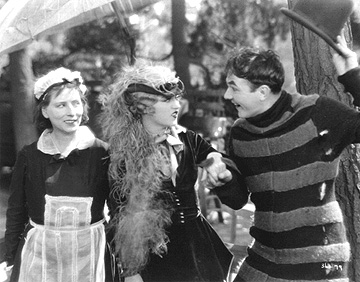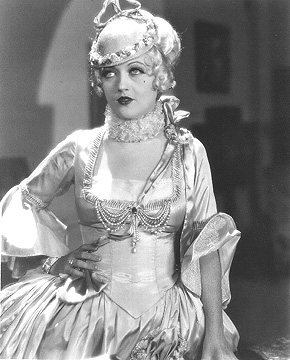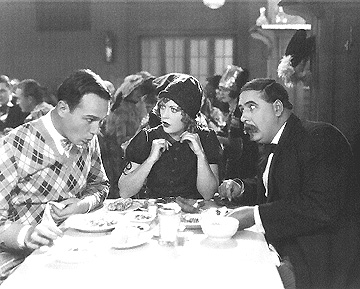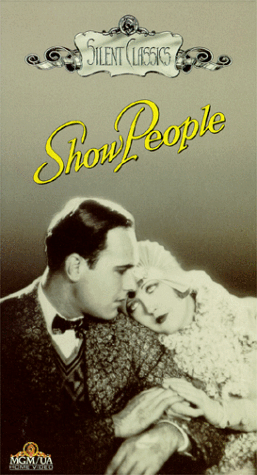FILM NOTES
FILM NOTES INDEX
NYS WRITERS INSTITUTE
HOME PAGE

(American, 1929, 82 minutes, b&w, 16mm)
Directed by King Vidor
Cast:
Marion Davies. . . . . . . . . . Peggy Pepper
Wiliam Haines . . . . . . . . . . Billy Boone
Dell Henderson . . . . . . . . . .Col. Pepper
Paul Ralli . . . . . . . . . . Andre Telefair
Tenen Holtz . . . . . . . . . . Casting Director
The
following film notes were prepared for the New York State Writers
Institute by Kevin Jack Hagopian, Senior Lecturer in Media Studies
at Pennsylvania State University:
There they are, arrayed around a table in the MGM commissary, the greatest stars in the cinematic firmament. Film history would never see a shot like this again. There's William S. Hart, Douglas Fairbanks, Sr., Norma Talmadge, and John Gilbert. There's Mae Murray and Renee Adoree, Rod LaRoque and Karl Dane, and there's Leatrice Joy and Claire Windsor and Aileen Pringle and Dorothy Sebastian and Polly Moran...
It is 1928, and this is a scene in King Vidor's witty Hollywood satire, SHOW PEOPLE, MGM was only five years old, but it was bursting with talent; Buster Keaton and Ramon Navarro, Lillian Gish and Norma Shearer, Lon Chaney and Greta Garbo; the prestigious MGM roster was the envy of Hollywood. Many of them lived extravagant lives, in fantastic, hideously overdecorated mansions, their garages stuffed with Duesenbergs, their guests sipping the finest bootleg champagne at midday. Frivolous and hedonistic, silent screen stardom was a fabulous Jazz Age whirl. At that moment, no two MGM performers loomed larger in the artificial constellation of movie stars than SHOW PEOPLE's leads, comedienne Marion Davies and handsome, athletic William Haines.
And yet SHOW PEOPLE is a document of a vanished epoch, for all of it, every single tinsel-struck silent dream, was to be swept away in a short year...
Marion Davies was the notorious mistress of William Randolph Hearst, prince of San Simeon and emperor of the American press. Davies had been a sparkling featured player in roustabout comedies when Hearst had become smitten with her. Now, under the banner of his own Cosmopolitan Productions, he had shepherded Davies through several elephantine costume epics. Most, like WHEN KNIGHTHOOD WAS IN FLOWER and BEVERLY OF GRAUSTARK, had tanked at the box office, but the public never knew it. Through Hearst's gossip columnist, Davies was presented as a rival to even the great Mary Pickford in America's affections, and MGM, fearful of Hearst's power, went on releasing the Cosmopolitan pictures as exercises in corporate welfare. Marion finally convinced Hearst to allow her to return to comedy, and her work in her previous film, the light, clever farce THE PATSY, also directed by Vidor, had been her best in years.
 SHOW PEOPLE may well be both Davies' and Haines' best film, a memento of two careers that are now both lost to all but toilers in film archives. Davies, as "Polly Pepper," is a Hollywood hopeful fresh in from the sticks, with a manic energy that substitutes nicely for either talent or beauty. Davies' mimicry was the toast of San Simeon, and SHOW PEOPLE is, among other things, an extended but good-natured jab at Gloria Swanson, then the screen's reigning glamour queen of the screen. The film's slapstick humor may also have reflected Davies' longing for her comic roots, but even here, Hearst intervened, insisting Marion not take the requisite custard pie in the face in a crucial scene. A squirt of seltzer water, he felt, would be more dignified. No matter, for Davies is in top form, and Polly's "acting audition" sequence, with its oddball, strenuous emoting, is one of the funniest bits in silent film.
SHOW PEOPLE may well be both Davies' and Haines' best film, a memento of two careers that are now both lost to all but toilers in film archives. Davies, as "Polly Pepper," is a Hollywood hopeful fresh in from the sticks, with a manic energy that substitutes nicely for either talent or beauty. Davies' mimicry was the toast of San Simeon, and SHOW PEOPLE is, among other things, an extended but good-natured jab at Gloria Swanson, then the screen's reigning glamour queen of the screen. The film's slapstick humor may also have reflected Davies' longing for her comic roots, but even here, Hearst intervened, insisting Marion not take the requisite custard pie in the face in a crucial scene. A squirt of seltzer water, he felt, would be more dignified. No matter, for Davies is in top form, and Polly's "acting audition" sequence, with its oddball, strenuous emoting, is one of the funniest bits in silent film.
Davies' co-star, William Haines, was the exemplar of a certain `Twenties type, now forgotten. Haines played hail fellows with names like "Tom Brown," handsome, breezy, graceful, and callow, perpetual adolescents each one. In a symposium on the contemporary film industry held at USC, MGM executive producer Irving Thalberg admiringly called him the characteristic hero of the period, with his "go and get it attitude." A blend of Harold Lloyd and Jay Gatsby, many thought Haines the perfect, all-American counterpoint to the suspiciously hermaphroditic Latin charms of Rudolph Valentino. Haines had been making films since 1922, and he'd been a star since 1926's TELL IT TO THE MARINES, with Lon Chaney. Haines was glib, a quick study, and a perfect delight to watch on the screen. In 1928, he was a front-rank star, and MGM was happily flooded with fan mail from Haines' adoring female fans.
 But William Haines was also gay, and lived a more uncloseted life than any other of Hollywood's many gay and bisexual stars. He and his longtime partner, Jimmie Shields, hosted the film community's most elegant parties, and he constantly twitted fan magazine writers about his "bachelorhood." His open flouting of convention drove MGM boss Louis B. Mayer nearly crazy, but Mayer's legendary hypocrisy about "family values" was matched only by his towering greed, and Haines' pictures were huge winners at the box office.
But William Haines was also gay, and lived a more uncloseted life than any other of Hollywood's many gay and bisexual stars. He and his longtime partner, Jimmie Shields, hosted the film community's most elegant parties, and he constantly twitted fan magazine writers about his "bachelorhood." His open flouting of convention drove MGM boss Louis B. Mayer nearly crazy, but Mayer's legendary hypocrisy about "family values" was matched only by his towering greed, and Haines' pictures were huge winners at the box office.
SHOW PEOPLE was no different, and Haines' wisecracking persona was never shown to better effect. Haines is "Billy Boone," a lowly chase-comedy actor, slogging away in two-reelers, when he befriends Polly. He helps her to the top, though he stays mired in filmdom's minor leagues. Down-to-earth, even cynical, but ever-loyal, Billy Boone is a perfect chum for the starstruck Polly, puncturing her worst illusions about Hollywood. (Their comradeship was not acting, for Haines and Davies were great friends.)
Yet, for all his complaining about Hollywood hokum, Billy Boone longs for success as much as Polly does, and works hard for it. In the end, SHOW PEOPLE is an warmhearted send-up, suspicious of pretense, but ready to embrace the motion picture for its most wondrous creation: the community of laughter and sentimental catharsis among strangers in a darkened theater. Not surprisingly, SHOW PEOPLE was a hit, for it is the silent film gloriously doing everything it did best.
During production of SHOW PEOPLE, sound hit Hollywood like a thunderclap. "Mike fright" drove some of the biggest stars, like Clara Bow, into deep seclusion, or the dubious comforts of the bottle. The Depression followed hard on the heels of sound, and the gigantic estates of the Hollywood royalty began to close their shutters and furlough their butlers. With them went an age of baroque splendor.
Soon, they were almost all gone, the `show people' of Vidor's film and of Olde Hollywoode. There were Talmadge, LaRoque, Adoree, and Navarro, all "retired" in their 30's; there was John Gilbert, drowning in alcohol; and Karl Dane, a pathetic suicide... Some, like Fairbanks and Pickford, hung on grimly for a time, but the age that had created them, and needed them, had passed. Only Garbo remained, her beauty suddenly exotic when once it had seemed emblematic of an age of screen gods and goddesses. Davies and Haines, of anyone, seemed immune even to sound's bitter truths, Davies because of Hearst's money, and Billy Haines because of a melodious voice and a devil-may-care manner his fans loved.
 Marion Davies' affair with Hearst insulated her for a time even from the Depression, but her delicate silent film acting style quickly became a non-sequitur in the sound era. Cosmopolitan shifted its operations to the more proletarian Warner Brothers, and Davies was finally deserted by what remained of her `Twenties fans. By the end of the 1930's, Davies, too, was "retired," ensconced in a 110-room, 55-bath "beach house" in Malibu, giving mammoth costume parties. Devoted to Hearst, she was with him until the end of his life and his fortune. After his death, locked out of San Simeon by Hearst's mortified family, there was only the bottle for solace. She lived out her days in the cobwebs-and-shadows world of the ex-silent movie star. It was a twilight of the soul deftly skewered in Billy Wilder's tragic SUNSET BOULEVARD, a film which ironically starred the target of SHOW PEOPLE's satire, Gloria Swanson.
Marion Davies' affair with Hearst insulated her for a time even from the Depression, but her delicate silent film acting style quickly became a non-sequitur in the sound era. Cosmopolitan shifted its operations to the more proletarian Warner Brothers, and Davies was finally deserted by what remained of her `Twenties fans. By the end of the 1930's, Davies, too, was "retired," ensconced in a 110-room, 55-bath "beach house" in Malibu, giving mammoth costume parties. Devoted to Hearst, she was with him until the end of his life and his fortune. After his death, locked out of San Simeon by Hearst's mortified family, there was only the bottle for solace. She lived out her days in the cobwebs-and-shadows world of the ex-silent movie star. It was a twilight of the soul deftly skewered in Billy Wilder's tragic SUNSET BOULEVARD, a film which ironically starred the target of SHOW PEOPLE's satire, Gloria Swanson.
Billy Haines continued to ride high for a time after SHOW PEOPLE and sound. Hollywood still talked of a "William Haines type," and MGM even invented Robert Montgomery just for the purpose. Haines was chosen to headline MGM's first true sound film, ALIAS JIMMY VALENTINE, in 1929. (SHOW PEOPLE, a transitional film, was released with a sound effects and music track.) His voice was deep and natural, the soft tones of his native Virginia giving his sound movie persona a trace of courtliness. ALIAS JIMMY VALENTINE and Haines' next few films were hits, and he was Hollywood's biggest box office draw of 1930.
But Haines' unconventional off-screen lifestyle was widely believed to be a specific target of increasing public posturing about morality by Hollywood censorship czar Will Hays. Cheerled by Mayer, the Hays Office produced its infamous Motion Picture Code in 1930, amending it in 1934. In between, Billy Haines' career peaked, stalled, and ended. Openly gay stars like Haines and Ramon Navarro were blacklisted, and others were driven deep into the closet. Haines, like many silent screen stars, finished his career in low-budget films produced by minor studios. It was all over by 1934.
But that was not the end for Haines. Resilient, he turned his hobbies of antique collecting and interior decorating into a profitable vocation, and William Haines, Inc. became the most renowned interior design firm in Southern California. Marion Davies was one of his most important early patrons. Soon, Billy Haines was decorating homes for all of Hollywood's elite, include the moguls who had blacklisted him, and from there his client list grew to include California's merchant princes and emerging conservative politicians. Ronald and Nancy Reagan were close friends, as well as clients, as were the Alfred Bloomingdales and the Walter Annenbergs, for whom Haines decorated the Ambassador's residence in London.
Haines and Davies remained close friends until her death in 1961. Billy admired Marion for sticking with Hearst, with whom he had been, oddly, great pals. Haines brought Davies out of seclusion for a last party in 1955, carefully costuming her, sobering her up, and demanding she get her jewelry out of a safe deposit box for the occasion. He was determined that her last public appearance would be as a star. Haines himself died in 1973, a millionaire and an internationally-famous decorator, and one of the real survivors from Hollywood's lost silent age. Ronald Reagan's public disapproval of homosexuality did not prevent him from gently consoling Jimmie Shields when Haines died. Shields was devastated. He quietly committed suicide just a few months after Haines' death. His note read, "Goodbye to all of you who have tried so hard to comfort me in my loss of William Haines, whom I have been with since 1926. I now find it impossible to go it alone -- I am much too lonely." By then, Billy Haines and Jimmie Shields had celebrated nearly fifty years together, and were widely regarded as the happiest couple in Hollywood.
When Billy Wilder shot SUNSET BOULEVARD in 1950, he asked William Haines to be a part of Gloria Swanson's "waxworks" gathering of washed-up silent film stars playing a desultory game of bridge. No, said Haines, he no longer thought of himself as an ex-movie star, and he was certainly anything but a has-been. Perhaps he simply didn't want to be reminded of the days of his vanished stardom, and of the mauve decades of the silent cinema. William Haines was by then Hollywood's most eminent interior decorator, and when he saw the film's architectural set-piece, Norma Desmond's decaying `20's mansion, he said that Wilder had gotten it just right:
Bebe Daniels, Norma Shearer, and Pola Negri all had homes with ugly interiors like that. I went through that period with all of them. Gold lace shawls draped over pianos and fancy vases filled with pussy willows. Our homes gave off the odor of milk and ashes.
— Kevin Hagopian, Penn State University
For additional information, contact the Writers Institute at 518-442-5620 or online at https://www.albany.edu/writers-inst.
 Show People
Show People